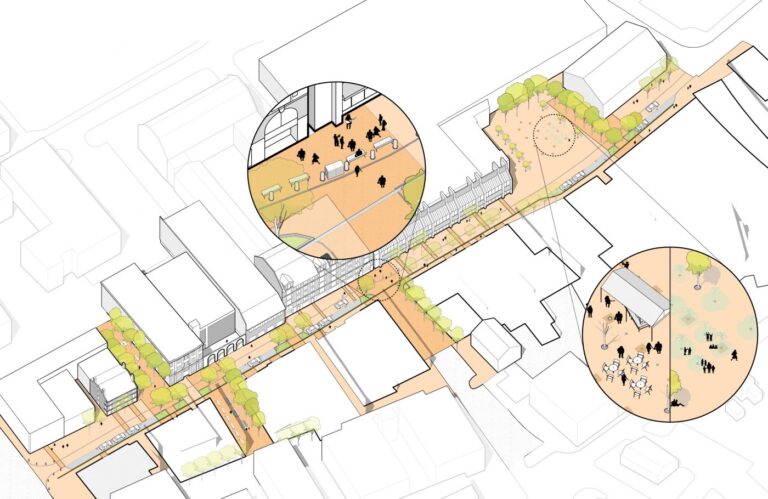“Pedestrian Patterns and Housing Trends: Analyzing Residential Choices in Walkable Urban Areas”
Inhabiting Walkable Neighborhoods: Exploring Housing Dynamics in Relation to Pedestrian Distribution”
INTRODUCTION
Many cities were walkable until the mid-19th century, as walking was the most common form of urban mobility (Singh, 2016). Even today, walking remains one of the most fundamental human activities and the most unconscious and rhythmic way of living and exploring the city (Diaconu, 2011).
Firstly, this study investigates how the built environment affects pedestrian dispersion in residential areas. Secondly, it aims to determine whether this effect differs between gated and non-gated housing types. Additionally, it focuses on the theoretical relationships between street configuration, functional use, physical structure, and pedestrian movement. (Yang and Vaughan, 2022).
 figure 01: Effects of urban structure on pavement systems (Sebastian van Arkel, 2015)
figure 01: Effects of urban structure on pavement systems (Sebastian van Arkel, 2015)
URBAN STRATEGIES GEOGRAPHICAL DISTRIBUTION:
The Diagram Above Shows How To Create A Larger Focus And Connect Nodes To Separate Functionality From The main spine. Creating Walkable Neighborhoods With Facilities That Reduce Motorized Travel Is Is Simple Yet Significant.
UNDERSTANDING PEDESTRIAN CONNECTIONS & BENEFITS.
Furthermore, pedestrians must feel safe and free to exercise their right to walk, and the urban environment must be pleasant. Additionally, a better understanding of pedestrian behavior can help improve the use of public spaces and the appropriate sizing of urban spaces such as historic centers, residential, and commercial spaces. (Yıldırım & Çelik, 2023).
Apartment complexes in contemporary Asian cities are characterized by the creation of large atrium complexes with building amenities. Building walkable apartment complexes is becoming more common (Lee & Park, 2022).
The most obvious benefits of outdoor walking include improving health both directly and indirectly by reducing polluting vehicular traffic directly (Hanson & Jones, 2015; Lee & Buchner, 2008; Olafsdottir et al., 2020).
CHARACTERISTICS TO IMPROVE PEDESTRIAN DISTRIBUTION.
- environmental micro-conditions
- comfort, safety.
- Quality of path and context.
In general, increased pedestrian traffic correlates with higher population density, a wider range of functional uses, and better pavement conditions (Yang and Vaughan, 2022).

figure 02: Planning & Urban Design Neighborhoods, Districts, & Streets(The Firm J.E.D.I., n.d.)
Understanding pedestrian dispersion is critical to creating livable, safe, and sustainable communities. In addition, there are some factors that affect pedestrian dispersion.
- Health & well-being
- Environmental sustainability
- Community connectivity
- Economic Vitality
Although, street network connectivity measured in most of the current studies reflects only metric characteristics of streets or physical connectivity. In addition, the primary visual connection has been largely ignored. So basically, higher physical connectivity means less time to reach the same number of destinations, and higher visual connectivity means fewer turns to see the same number of destinations.
Despite the relevance of these two connection structures, the study of physical and visual connections is essential to better understand the role of the street network in pedestrian activities. (Hajrasouliha & Yin, 2014)
SOLUTIONS TO PROMOTE PEDESTRIAN DISPERSION:
- Complete streets
- Mixed-use development
- Public space Enhancement
- Community Engagement & Education
- Pedestrian-oriented design principles
- Traffic calming measures.
- Green space integration

figure 03: Planning & Urban Design Neighborhoods, Districts, & Streets
(‘Essex Street Pedestrian Mall – Utile Architecture & Planning’, n.d.)
In other words, it promotes the development of more active public areas and increases active mobility. Many urban dwellers are more likely to engage in physical activity when living in walkable areas with wider sidewalks, shade, and connections to many attractions. (Grahn un Stiesdotter, 2010).
Conclusion:
Moreover, pedestrian dispersion in residential areas is influenced by the complex interactions between factors such as the built environment, land use, safety, social dynamics, and cultural norms. Additionally, understanding these factors and their impact is critical to creating walkable communities that promote health, sustainability, community connectivity, and economic viability. Furthermore, by implementing solutions such as complete streets, mixed-use development, public space improvements, and community engagement, city planners and policymakers can support walking and create vibrant, livable environments for all residents.


